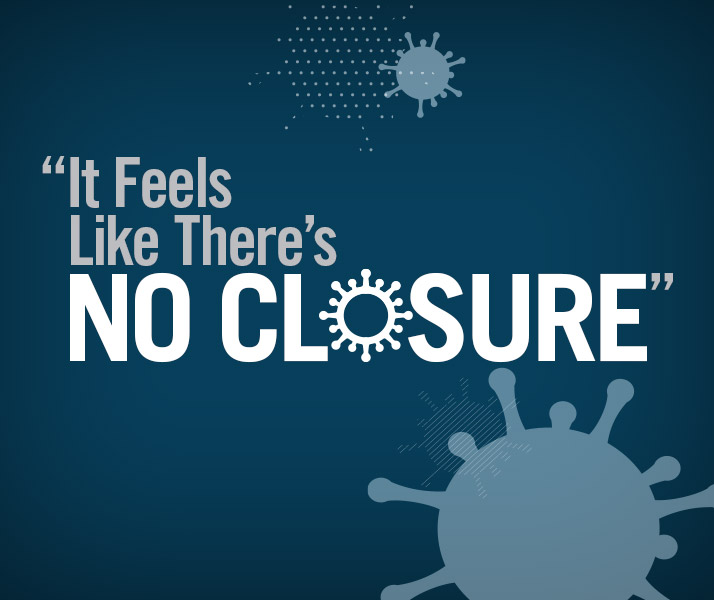
“It Feels Like There’s No Closure”
By Beth JoJack ’98
As this magazine issue goes to press, more than 440,000 people globally have died from COVID-19.
Much of the world shut down in March to slow the spread of the coronavirus — and that was true for Hollins, too. On March 20, Interim President Nancy Oliver Gray announced classes would be held online for the remainder of the semester. In a heartbreaking blow for Hollins seniors, commencement had to be postponed.
Just as the pandemic has affected people all over the globe, members of the Hollins community have seen their day-to-day existence altered by the virus. Here, we’ve gathered stories from students, alumnae, and faculty on how COVID-19 impacted their lives.
Courtney Legum-Wenk ’03 is an OB-GYN at Virginia Women’s Center in Richmond. She’s preparing herself for the second wave of COVID-19 that she believes is likely to hit the state in the fall.
So my practice is obstetrics and gynecology, and we cover four hospitals in the Richmond community. Very early in the crisis, we decided that as a practice, we would take half of our doctors and throw them into the hospital to only do hospital medicine. And then the other half would be just in the office. I was one of the ones who went into the hospital. I specifically go to Henrico Doctors’ Hospital Forest Campus, and I was there doing shift work for about seven-and-a-half weeks.
It was definitely hard at the beginning because each hospital was trying to do their very best with whatever protocol they decided on, but those protocols would often change daily. My fellow call partners and myself decided very early we would wear the N95 masks for all deliveries. My hospital didn’t start endorsing this policy until just three weeks ago.
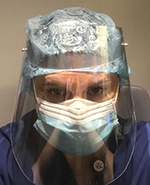 We have had several positives [positive tests for COVID-19] not just at my practice, but in labor and delivery at the hospital. What’s been hard from the women’s health perspective is there’s so much that is unknown. At first they were like, “Oh, there’s no transmission to the baby,” but then a case study from China suggests it’s a possibility—which is very scary. We have been lucky; at my hospital there have been no deaths from a women’s health perspective. However, my emergency room friend declared 10 people dead in one shift. This is local. It isn’t New York. It’s not Seattle. This is Henrico County.
We have had several positives [positive tests for COVID-19] not just at my practice, but in labor and delivery at the hospital. What’s been hard from the women’s health perspective is there’s so much that is unknown. At first they were like, “Oh, there’s no transmission to the baby,” but then a case study from China suggests it’s a possibility—which is very scary. We have been lucky; at my hospital there have been no deaths from a women’s health perspective. However, my emergency room friend declared 10 people dead in one shift. This is local. It isn’t New York. It’s not Seattle. This is Henrico County.
The first couple of weeks were personally very hard. My husband is a pediatric ICU nurse at VCU, and I was pretty worried about him because he’s also a volunteer paramedic, and rides with one of the local rescue squads. So he is a health care worker in one of the largest teaching hospitals, as well as being out in the community on the ambulance. We’ve developed an entire system for when we enter the house that involves immediately going to the basement, removing all clothing, showering and then putting our clothes, which potentially could carry the coronavirus, in the washer. I have designated shoes, pens, highlighters, and my hospital badge, which now stays in the car unless being used, and I Clorox wipe my car every morning on my way to work.
In March, my husband and I pulled out our wills, our power of attorney documents, and our medical advance directives. We reviewed our wishes and told our beneficiaries where in the house they could find the originals and copies, just in case. We even wrote down who gets Wink, our beloved bulldog, if tragedy hits. We have had very serious discussions between ourselves and with our friends who are also in health care regarding whether or not we want to be on a ventilator if we contracted COVID. Most of us have said out loud, “No!”
I’ve had the personal protective equipment needed because some of it I obtained on my own; I have had friends who have given us masks and gloves, and my practice was very proactive at the beginning. PPE wasn’t lacking at the hospital, but there were strict rules to access it. I have banked several N95 masks and face shields at home that I haven’t used because I’m purposely waiting, just in case there’s an emergency.
Now things are opening up. I’m back in the office for certain days and we’re slowly transitioning to a more normal schedule. I haven’t had a direct exposure to a patient with COVID-19 that I know of, but I’ve had exposure to other physicians who’ve had exposures. I have a young patient who lost her partner to COVID-19 and another patient with COVID-19, who is younger than me, without any health issues, who had to be admitted to the ICU. None of my colleagues have tested positive yet.
We’re still wearing masks all the time. It’s the new normal, even just in basic clinical practice in the office. Basically, I take it off only to drink water, eat, and go to the bathroom. We’re not seeing the same capacity of patients as before, so we don’t have as many people in the waiting room area. Patients can’t bring visitors to their appointments, which has really impacted the pregnant patients who want their partners with them.
 Tons of people have reached out, especially the local Hollins girls I’m friends with. People have made me masks and sent gifts. I have probably written more handwritten thank-you cards this year than I’ve written since my wedding. I’m grateful for our scenario that we haven’t had a catastrophic event, and that both myself and my husband have stayed healthy. But there has been a certain level of guilt because I haven’t had it as bad as other doctors. I question whether I’m deserving of these gifts and the recognition. You hear these other stories that are just so much worse. All I want to do is hug these doctors and nurses who have seen all of this tragedy firsthand. Consequently, treating the long-term mental health of our health care workers after this pandemic is going to be really important. There’s going to be some serious PTSD. We need to learn now how to address it before it becomes its own pandemic.
Tons of people have reached out, especially the local Hollins girls I’m friends with. People have made me masks and sent gifts. I have probably written more handwritten thank-you cards this year than I’ve written since my wedding. I’m grateful for our scenario that we haven’t had a catastrophic event, and that both myself and my husband have stayed healthy. But there has been a certain level of guilt because I haven’t had it as bad as other doctors. I question whether I’m deserving of these gifts and the recognition. You hear these other stories that are just so much worse. All I want to do is hug these doctors and nurses who have seen all of this tragedy firsthand. Consequently, treating the long-term mental health of our health care workers after this pandemic is going to be really important. There’s going to be some serious PTSD. We need to learn now how to address it before it becomes its own pandemic.
— As told to Beth JoJack ’98, who lives and writes in Roanoke.
![]()
Maureen Lytle ’20 of Fairfield, Pennsylvania, heard about the coronavirus not long after returning to Hollins from New York City, where she completed a J-Term internship at the nonprofit America Needs You, which assists low-income, first-generation college students.
I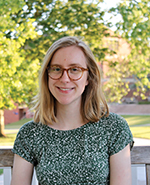 t was right after my internship that we heard about what was happening, and we didn’t really know whether it would affect us at all or how serious it was going to get. From the news we heard, we knew it originated in China, and we didn’t know how it was going to spread. Once we knew that there were U.S. cases, we were paying close attention to the news from surrounding schools to see what they were doing to address the situation. On March 13, the administrators said we were going to go into spring break a week early. I got approval to stay on campus longer because I wanted to continue working at the Eleanor D. Wilson Museum, where I was an assistant, as long as possible. I didn’t know if I was going to have a job when (or if) we returned.
t was right after my internship that we heard about what was happening, and we didn’t really know whether it would affect us at all or how serious it was going to get. From the news we heard, we knew it originated in China, and we didn’t know how it was going to spread. Once we knew that there were U.S. cases, we were paying close attention to the news from surrounding schools to see what they were doing to address the situation. On March 13, the administrators said we were going to go into spring break a week early. I got approval to stay on campus longer because I wanted to continue working at the Eleanor D. Wilson Museum, where I was an assistant, as long as possible. I didn’t know if I was going to have a job when (or if) we returned.
I found out we were transitioning to virtual learning on March 21. Since I read the announcement the day before I left Hollins to return home, I was able to pack up most of my belongings. I was quite upset when I found out we were going to have class online for the rest of the semester. I cried a lot and thought, “Okay, it’s actually over.” I slowly processed all the things that weren’t going to happen, like things I wanted to do in Roanoke one last time. Things like going to the top of Mill Mountain at night again with my friends, or going to Benny’s for a late-night slice. I was thinking, “Should I have done all these things sooner?” But I still had classwork to do, so I figured I should focus on my studies first.
For my major in gender and women’s studies, we had an oral presentation where we present our final capstone projects. Since our class was really small, only three students in all, we got to work together closely and curated our projects together. I was really looking forward to going through that process with them and our advisor. My paper is an autoethnography titled, “The Influence of Whiteness on My Familial Relationships Through Ownership, Capitalism, and Disconnection.” Doing a project that revolves around your family while being surrounded by those family members is a unique challenge, and one I was not anticipating.
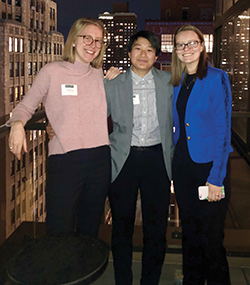
Maureen Lytle ’20, Mitch Mitchell ’20,
and Kalyn Chapman ’20.
My girlfriend, who was one of my roommates at Hollins, lives in Manassas, Virginia, which is about two hours away from where I live. I went to her house for a couple of days in May and then we drove down in her van on the first day we were allowed to pack up our belongings at Hollins. We packed up our apartment and then we went to Bobby’s Hot and Cheesy for pizza and Blue Cow for ice cream. Then we went back to Hollins and finished up. It was sad to leave Hollins, but I knew I’d be back eventually.
It feels like there’s no closure. As a senior, at Hollins especially, we have so many traditions to participate in at the end of the year. We have senior week, which is a weeklong celebration the week before graduation, where we can spend time with friends and say all our final goodbyes. I’ll probably never get to say goodbye to so many of the people who made my Hollins experience memorable.
My parents had a hotel booked for graduation, which they canceled once we heard the news. My parents, sister, and grandmother were going to attend. I’m not sure if I’ll be at the graduation in September* yet depending on where I’m living and my financial situation. Graduation is a momentous occasion, especially for first-generation college students. It is a moment of triumph and celebration where you can show your family all you’ve accomplished. I don’t think I’m going to have that moment in the same capacity.
Whenever I get upset about what happened, though, I remember, “Just think of the alternative.” We could have attended Hollins for the rest of the semester, but that wouldn’t have been safe. People’s health is at risk. I think we can be upset about what happened while understanding why it happened. It can be both.
I’m planning on finding a job in New York City and moving there. I want to live in a big city when I’m young. I wasn’t anticipating going to NYC at first. While living in the city during January for my internship, I thought it might be a little much to live there full time. But there are so many Hollins alums there who are willing to help and so many nonprofits (which is what I want to do). Now, that’s where I see myself going.
I’m applying to jobs every day and hoping I find the right opportunity. I’m trying to stay motivated because it’s easy to think, “Oh, I’ll be fine. I just need to wait it out.” I want to really push hard now to make it happen.
— As told to Beth JoJack ’98
* Hollins’ 178th commencement exercises have since been rescheduled for Memorial Day Weekend of 2021.
![]()
Ernie Zulia, associate professor and chair of the Hollins theatre department, was midway through rehearsals for Hollins’ spring production of The Curious Incident of the Dog in the Night-time when the lights went out on campus.
Curious Incident is a show full of wonder and heart, and the entire cast had been basking in the deep satisfaction of a rich and exciting rehearsal process before this work we love was called to a halt. What to do? Continuing rehearsals in Zoomland was not practical. So out came the calendars and timelines, and come September, we are planning to pick up where we left off to open the show on October 22. So with determination, passion, and some good ole theatrical grit, we are embracing the old adage that the show must go on!
While we couldn’t rehearse in Zoomland, we did find ourselves going to class in this strange and foreign place online. My favorite class is called “Passion, Possibilities and Purpose: Personalizing the Art of Making Theatre.” It’s a practical philosophy class, and is based in some pretty powerful discussion. The first day we met in Zoomland, we spent a lot of time checking in with each other and sharing a lot of feelings about our strange new circumstances. One of the things that came up a lot was how weird it was to be back at home, locked in with parents after experiencing an independent adult life at Hollins. I could totally relate…but from a very different point of view.
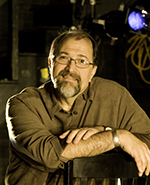 At 5 a.m. the morning of March 14, two days after our last day of face-to-face classes, I was awakened by a call from Akron, Ohio. My 94-year-old dad had been rushed to the hospital with a torn muscle, which triggered a pretty severe heart incident. My 91-year-old mom was in lock-down at the retirement community they’d been living at for the past 14 months. Dad was alone in a hospital, and like the boogey man, the coronavirus was lurking under beds and behind doors and in closets.
At 5 a.m. the morning of March 14, two days after our last day of face-to-face classes, I was awakened by a call from Akron, Ohio. My 94-year-old dad had been rushed to the hospital with a torn muscle, which triggered a pretty severe heart incident. My 91-year-old mom was in lock-down at the retirement community they’d been living at for the past 14 months. Dad was alone in a hospital, and like the boogey man, the coronavirus was lurking under beds and behind doors and in closets.
After being so discombobulated by the shutdown of our campus, I suddenly felt blessed that I could grab my computer and office files and rush up to Ohio to be at my dad’s bedside so he wouldn’t have to be alone in the hospital. Ninety-four-year-olds are easily confused and disoriented, so I was grateful to be able to hold my dad’s hand and help him feel safe. He’s a World War II veteran and always felt it was his job to make others feel safe. Tables do turn.
It’s now five weeks later, and like so many of my students, I’ve been living in quarantine with my parents. Dad needed 24-hour care, but the managers of the community were very skeptical about allowing a parade of caregivers to come through the doors and risk infecting the entire community. So even though family members are forbidden to visit, we struck a bargain: as long as I was willing to go into quarantine with them, I could move in and be their full-time caregiver.
I’m writing this in the fourth week of not setting foot outside a three-room independent living apartment…and you know what, it’s been kinda wonderful. I teach and conduct theatre department business from my computer in the small den and sleep on the pull-out sofa in the living room. But more importantly, I’ve been given the gift of some mighty precious time with two people I love. They’re not going to be around much longer (virus or no virus), so I consider these unexpected circumstances a real gift; precious time to hear poignant and funny stories of days gone by. But even better, I’ve been given the rare opportunity to care for them the way they once cared for me when I was a vulnerable and defenseless child. In many ways, the elderly are quite child-like, which allows them to be more open and free to share their hearts and souls and the richness of lives well-lived. And I get to be there to check under the bed for monsters before we turn the lights out.
When this COVID craziness began, I never expected it to turn into such a blessed time, filled with so much love. I hope our entire Hollins family can find some semblance of a silver lining in this unprecedented time we are living through. As for me, being locked in with parents has turned into a true gift.
This is an edited version of an editorial written by Ernie Zulia that was also published in The Roanoke Times on May 3, 2020.
![]()
Erin Slattery-Duda ’98 received an email from her daughter’s school on March 11, announcing students would transition to online learning the next day. The school was closing to slow the spread of the coronavirus.
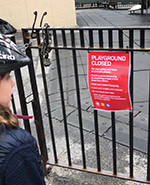 The next afternoon, I took my daughter, Madeleine, to ride her scooter in the P.S. 187 schoolyard, a five-minute walk north from our apartment on the west side of Washington Heights in Manhattan. A dozen kids were there, zooming around on scooters, bikes, and roller skates, shouting in the late sunshine. My daughter raced off with glee with friends from our co-op apartment complex. I walked over to a friend—the mother of twin girls, my daughter’s friends—sitting on the ground at the edge of the schoolyard. She looked anxious. We watched our girls circle the schoolyard in a blur of flying hair and chrome, and then she grimaced.
The next afternoon, I took my daughter, Madeleine, to ride her scooter in the P.S. 187 schoolyard, a five-minute walk north from our apartment on the west side of Washington Heights in Manhattan. A dozen kids were there, zooming around on scooters, bikes, and roller skates, shouting in the late sunshine. My daughter raced off with glee with friends from our co-op apartment complex. I walked over to a friend—the mother of twin girls, my daughter’s friends—sitting on the ground at the edge of the schoolyard. She looked anxious. We watched our girls circle the schoolyard in a blur of flying hair and chrome, and then she grimaced.
“Seven-year-olds just don’t get the idea of social distancing,” she said, getting up.
I didn’t blame her at all, but my heart sank as my friend caught up to her girls and said a few words. The twins got off their scooters, looked up at their mom, and then followed her out of the schoolyard, glancing back at their friends. It felt like a punch in the gut. My daughter watched the twins go, then came over and slumped against me, upset, letting her scooter fall on its side.
The afternoon was a glimpse of the disappointment and confusion (especially for kids) that would come next. Everything began to be canceled—school, a work dinner, work. Then the cancellations rolled into the weeks beyond, engulfing playdates, kids’ birthday parties and trips, as city hall urged residents to stay home. For our first-grader (as for so many other kids around New York City and around the world), it meant spending the last rainy weeks of March and early April cooped up with parents, mourning the temporary loss of friends in explosive ways that neither she nor we really understood.
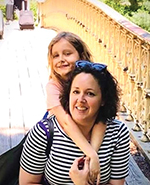
Erin Slattery-Duda ’98 with daughter Madeleine.
We spent the first weeks of quarantine adjusting to all the sudden togetherness, feeling joyful one moment (having all three of us at home for dinner was an unexpected silver lining, even though the idea of a silver lining to a pandemic seemed wrong) and fearful, guilty, and frantic with worry the next. How would we quarantine one of us in our small apartment? What would happen to our daughter if both of us got sick? Was what was happening in Elmhurst, Queens, about to happen elsewhere in the city? Did we have a will? In disbelief, I sent a text to my brother and sister-in-law, asking them to be Madeleine’s guardians. We ordered plastic drop cloths to turn an eight-foot by four-foot space off our hallway that held bookshelves into a sick bay if we needed.
It was absurd. It felt inevitable that anyone left in the city would get it.
Our kid kicked off the first Monday of school online by showing up to breakfast in a narwhal costume. “Are we going to be okay?” she asked through a mouthful of granola. My husband, Jakub, and I looked at each other.
“I…hope so?” I said. By then, we’d stocked up on masks and weren’t making any trips out of our neighborhood. But we soon began a kind of parallel living—during the day, cheerful and optimistic in front of our daughter; at night, watching news footage from China, Italy, and Queens, scared and drained.
A week later, in Bennett Park, outside our apartment complex, we noticed that the city had locked the playground gates. Signs told New Yorkers that the playgrounds were closed until further notice. Everyone had deserted the park anyway, as the March rain began; only an occasional patrol car slowly went through the park with its lights on.
Although our neighborhood seemed empty, ambulances were everywhere. You become used to the sound of sirens here, but suddenly it was nonstop.
The one daily moment when everyone seemed to let out the breath they’d been holding all day was at 7 p.m., when neighborhoods leaned out the window and began to bang pots and pans in a show of support for health care workers. Our daughter joyfully smashed a saucepan and lid together at our kitchen window while neighbors across the courtyard, at their windows, did the same. One night, we were in the park at 7 p.m., and the sound was like an orchestra when the musicians take a deep breath and play one note, all at the same time: whistling, shouting, clashing pots and pans, drums, and the sound of a shofar rose up from apartment buildings on all sides.
We tried to order groceries online, rather than going to the supermarket. But the usual local delivery services, Peapod and FreshDirect, were swamped, and as soon as someone discovered a grocery delivery service with a few available delivery times, the city converged on it. Bent over my laptop in a makeshift office under our games shelf, trying not to bang my head on the shelf above me, I tried to figure out how to get groceries.
A couple of restaurant supply companies had pivoted to online retail; with another family in our apartment complex, we split an order that included 10 lbs. of chicken, eight lbs. of fruit, and 10 lbs. of carrots in a bright-orange bag the size of a toddler. The $10 we spent on a box of 200 small chocolate pieces, ostensibly for baking but great for stress-eating, remains the best purchase I made this spring.
Desperate to get out of the house, I started taking Madeleine to ride her scooter or bike in Bennett Park. By late April, other parents and kids began to come to the park, and we stood the requisite six feet apart, shivering, and trying to make normal parents-in-the-park conversation. It emerged that one family in our apartment complex had had the virus in March, but continued to come to the park, initially without masks, so their daughter could ride her bike. I remembered being at the park with them, and remembered the dad coughing at length. I felt a mix of shock, anger, and suspicion. What did it mean for everyone else’s kids? We were all just coasting on the hope that children didn’t seem to be coming down with the virus nearly as fast or as often as adults and the elderly. But was it nuts to hold that hope?
I knew there was a stark difference between my family’s experience this spring and that of families living on the east side of Washington Heights (and, beyond that, in the Bronx, hit almost as badly as Queens by the coronavirus). The coronavirus outbreak was so much more deeply felt a short walk away than in our neighborhood that the issues I dealt with—which grocery delivery service to use, whether to let my kid bike outside in the large, leafy park for an hour, how many Amazon deliveries was too many—were trivial. Being able to quarantine was a privilege. How you quarantined was a privilege. As April went into May, we looked for ways to support rent-cancellation drives, donate to a local food pantry, and contribute to a fundraiser for small-business owners in Upper Manhattan. None of it felt like enough, and none of it would be enough.
— Written by Erin Slattery-Duda ’98, a freelance writer and editor living in New York City.
![]()
LeeRay Costa, professor and director of the gender and women’s studies department and director of faculty development, went to her office on March 15 to gather her books, files, course materials, and supplies with the hope that this new arrangement of working from home and teaching remotely would be temporary.
As I’m writing this, seven weeks have now passed and we have begun our last week of spring classes. On the one hand, I am admittedly relieved that what sometimes feels like the terrible, horrible, awful, no-good spring semester is finally coming to an end. On the other hand, I deeply miss my Hollins students and colleagues. And while I have secretly come to loathe the #Zoomlife and its inability to capture the joyful energy of being physically together, I cherish every moment I get to see you and talk with you, even on a screen. Unlike most of our students, I have the freedom and ability to return to campus, but I have avoided doing so because I can’t bear the thought of being there without all of you. This separation weighs heavily upon my heart and there have been days during this quarantine when I have felt unmoored and lost. I imagine you may have felt that way too.
 This feeling of being lost conjures my experience of being a pilgrim. Five years ago during my sabbatical, I embarked on a pilgrimage. Over the span of 33 days, I walked 400 miles from Lisbon, Portugal to Santiago, Spain on the Way of St. James, also known as the Camino de Santiago. I walked for many reasons: personal, professional, physical, and spiritual, and imagined myself following in the footsteps of my Portuguese ancestors.
This feeling of being lost conjures my experience of being a pilgrim. Five years ago during my sabbatical, I embarked on a pilgrimage. Over the span of 33 days, I walked 400 miles from Lisbon, Portugal to Santiago, Spain on the Way of St. James, also known as the Camino de Santiago. I walked for many reasons: personal, professional, physical, and spiritual, and imagined myself following in the footsteps of my Portuguese ancestors.
My journey was a decade in the making, and I had prepared for months before embarking on it. Nevertheless there were days when I found myself off track and distressed. The truth is, even when we think we know the path and have a map to give us direction, we may unexpectedly find ourselves lost along the way. This lostness can be disorienting and even scary. And it can simultaneously offer up profound life lessons: crystalizing for us our strengths and sense of purpose and illuminating for us what we cherish most.
The Camino de Santiago is indicated by a series of waymarkers, usually yellow arrows or golden scallop shells. These are maintained by volunteers of local pilgrim associations and offered as an act of kindness and support for those making the journey. As I walked, those waymarkers provided me with a sense of confidence and reassurance. I smiled and whispered my gratitude each time I discovered one.
More often than not, camino waymarkers are easily visible, though sometimes they are hidden, and occasionally they are present yet terribly confusing. I will never forget a particular section of the camino near Porriño. Apparently, members of the community surrounding this area were arguing over the route. Some wanted it to flow directly through the very industrial and concrete center, so that they could benefit economically from the pilgrims who were likely to stop and buy food and supplies. Others wanted to divert pilgrims to a path through the woods, to preserve the reflective nature of their journey and to physically prevent them from walking on dangerously trafficked roads. What resulted were a series of competing waymarkers that had been repeatedly covered over, with new arrows spray painted in their place. Each morning individuals from opposing sides would set out to conceal the marks of their rivals. For unsuspecting pilgrims like me this resulted in confusion about the way forward and dread that I might make a wrong turn and lose my way.
There have been days during the quarantine when I have felt transported to that moment of fear, confusion and anger over a situation I did not create but must figure out how to handle. Like many of you, I have stumbled my way through new modes of teaching, learning, working, communicating and sharing space and resources with folks whom I love dearly but who occasionally get on my nerves. I have had to make hard choices about what and whom to prioritize and how to get the necessary tasks of everyday living accomplished while struggling with a lack of motivation and tearfully mourning the many losses I have experienced and continue to witness all around me. I have felt the despair of not knowing what lies ahead and longed for the unambiguous waymarkers that remind me that everything is going to be all right.
My pilgrim experience also reminds me that sometimes those clear and reassuring waymarkers are actually right in front of me, but I remain unable to recognize them. This may be because I am distracted and have let my attention wander, or because I am so lost in the story unfolding in my own mind that I have ignored the signs all around me telling me and showing me something quite different. As I have revisited these lessons and brought them to bear on the current moment, I have realized that at least some of this feeling of being unmoored and lost is tied to the experience of being displaced: displaced from our beautiful campus, our beloved Hollins community, and our treasured rituals that create a sense of certainty, connection, and shared purpose.
And yet, even in this displacement, our waymarkers remain. Because whether you recognize it or not, each one of us — students, faculty, staff, administrators, alumnae/i — is a yellow arrow, a golden camino shell, for someone else in our community. Individually and collectively, we provide direction, reassurance, a sense of calm and support for one another, no matter where we happen to be currently residing. Perhaps this is something our alumnae/i know best, scattered as they are across the globe but forever knitted into the Hollins experience.
These waymarkers, embodied in the members of the Hollins community, inspire me and remind me that no matter how isolated or lost I may feel, I am not alone. Through our relationships, our shared experiences and our mutual care for one another, we form a network of connection and hope that transcends both time and place, and that can anchor and fortify us in these unpredictable times. As we continue through the end of the term, into summer and beyond, I encourage you to look for the yellow arrows and golden scallop shells that surround you, to delight in their shine and to give thanks for their presence on our collective journey.
—Written by LeeRay Costa
![]()
When masks began selling out in Korea, Josalyn Knapic M.F.A. ’17 realized the world was about to change.
Songdo is a neighborhood in the city of Incheon built on manmade land. Our neighborhood runs along the seaside, with downtown Incheon and Seoul to our east and the Yellow Sea and China directly to our west. Songdo’s aesthetic is the complete opposite of the rest of Korea. There is abundant and open space, at least four lanes for traffic, and clusters of apartment housing are surrounded by large artificial parks. Much of the land is still underdeveloped, as blocks of tall reeds grow next to new shiny buildings next to construction sites. Restaurants and shops are clustered here and spread out. Many residents rely on driving.
I came here for a job teaching at the first American university in Korea. Upon moving to Songdo, I immediately missed Daejeon’s convoluted alleyways, its lively streets, the mom-and-pop stores on every corner, old brick houses scrunched up next to each other with their traditional ornate gates, decorated roof tiles and kimchi pots. When I moved to a modern high-rise at the edge of Songdo, I felt I lost something special. But as the virus started to spread throughout Korea, I couldn’t help thinking that the large open roads and wetland that surrounded our area was something to be grateful for.
Then—January
Korea is a mask-wearing country—there are masks in convenience stores, grocery stores, and pharmacies. In Korea, it is very common for people to wear a mask regardless of time of day. It could be used to hide a puffy face after a night out drinking, to aid against Korea’s air pollution, to protect a surgical procedure, a developing cough, or just an easy way to hide from looking particularly haggard that day.
A week or so after the news of COVID-19 was beginning to spread in China, my in-laws and I were on our way to Korea’s Jeju-do, an island southwest of the Korean peninsula. We had planned a four-day family trip.
It took us driving to three grocery stores to find enough KF94 masks for everyone to last the whole trip. Residents crowded the mask sections at the grocery stores as workers cut open delivery boxes.
As we took in Jeju’s natural landmark sites, we also took in the news from televisions in restaurants and our hotels. We watched how the virus was declared an imminent threat, and how Koreans were demanding the president to ban Chinese from entering its borders. Instead, travel advisories were issued and a limited ban to foreigners from China’s Hubei province was made.
Then—February
We were kept informed as patient numbers grew. The government still refused to close borders, but the authorities began warning everyone to stay indoors and avoid crowds and large gatherings. People listened. Hand sanitizers were duct-taped inside elevators. Restaurants and shops began closing a little earlier than usual. People wore masks everywhere, even in offices.
Brief text messages in Korean accompanied by a red megaphone began to appear up to four times a day on our phones: Korea’s emergency alert system. Its occasional alerts usually warned people about air pollution, but now they were about the coronavirus.
Cases started to appear closer to our neighborhood. The 19th patient was confirmed at an outlet mall four blocks from our house. The shopping mall closed for two days for disinfection. Driving in a taxi on the way home from a dermatology appointment, I saw a large truck with a mixer on its back spraying a fog of sanitizer, coating the parking lot. Workers in hazmat suits sprayed sanitizing guns all over the sidewalks.
Then and Now
To understand Korea’s successful response to COVID-19 is to be aware of Korea’s tumultuous past with its neighboring countries. From defending itself against attacks from China, overcoming a decades-long colonization by Japan and its own military dictatorship, as a nation Korea has learned that survival depends on the tenacity of its people. Korea has also been technically at war with communist North Korea since 1953, even when day-to-day life here makes you forget this.
When difficult times arrive in Korea, there is an unspoken trust that the people will band together and fight against it. Korea is a collectivist culture, while America is an individualistic one. As my students and I learn about these differences in class, each type of culture brings advantages and disadvantages. In a nationwide crisis, I have to say that a collective culture and its “hive mind” mentality is beneficial for all citizens.
Now—March
My husband and I take a trip to the grocery store. When we arrive, we are surprised to witness a long line of people waiting at the pharmacy. They stand close to each other, eager for the line to begin moving. The pharmacist, a man in a white coat, is talking to the people near the front.
Pharmacies are scheduling mask distribution times, two boxes per person. We contemplate waiting in line until we see it—the line wraps all the way to other end of the building.
I tell relatives back in the States: buy N95 masks, buy a thermometer. Check temperatures.
Then—February
One reason Korea’s response to COVID-19 has been swift is that health care in Korea is affordable, reliable, and easily accessible.
After the MERS epidemic in 2015, Korea’s Centers for Disease Control reassessed its systems and gave priority to learning how to better handle infectious diseases. After the fourth COVID-19 patient was confirmed in Korea, researchers had enough hindsight to believe this to be a possible pandemic and acted accordingly. They also believed early testing was the only way to prevent the virus from spreading.
Residents were urged not to go into hospitals to reduce the chance of infecting workers and other patients. Instead, screening centers were set up. For perspective, South Korea is roughly the size of Indiana. Preparations were made for 635 clinics and screening centers.
If someone exhibits symptoms, they are told to call a special number to find the location of the nearest screening center or, if needed, authorized paramedics.
If one does have to go to the hospital, workers do a preliminary screening to anyone who enters.
I visited a local university hospital to discuss bloodwork I had done a month prior. Once there, I found all the entrances blocked except one. Hospital workers in hazmat suits were lined up at tables inside with forms written in Korean. Not understanding at first, and with no one approaching me, I tried to simply walk through. I stood there, confused, until another worker finally put a form written in English in my hand. It asked for my identification details, if I or a relative had visited China recently, and when, and if I exhibited any symptoms. I signed the form. Only after they took my temperature was I let through.
Now—March
My in-laws video chat us from Daejeon. My father-in-law just finished self-quarantine and tested negative. They are celebrating with fried chicken. They ask how my parents are doing. I haven’t talked to my parents since last month, when the virus was beginning to spread. My mom and dad are both nurses.
I text my mom to ask how everyone is. She tells me about my four siblings in the U.S.—some are working from home; some are not.
I ask if they were being provided hazmat suits at work. My mom says they were used two weeks ago for a suspected TB case, but she doesn’t know how many are available. She tells me they designated the fourth floor of her hospital for potential virus patients, and they were asking for more hazmat suits. However, they are worried that companies will be too swamped with orders to deliver soon. My dad works at a surgical center, but his hours have been cut in half. My mom tells me they are excited that he just got extra work being a visitor screener at the main entrance to the hospital. For the first time, I begin to feel a little nervous.
When she told my dad I texted, he wanted her to tell me: “What doesn’t kill you makes you stronger.”
Then she adds, “He’s joking as usual.”
The feeling in the pit of my stomach grows.
—A longer version of this essay, written by Josalyn Knapic ran in the online literary journal Scoundrel Time on March 31. Reprinted with permission.
![]()
Sajila Kanwal ’22 travels from Gilgit, Pakistan, to Hollins, where she’s majoring in international studies and minoring in social justice. In early March, Kanwal panicked when she heard her fellow students buzzing about the possibility that the campus might close because of the coronavirus.
My mind was racing, and I didn’t know what to do. I couldn’t go home to Pakistan because I was scared that I would get coronavirus while I was traveling, and I didn’t want to give this virus to my family. Because I live in northern Pakistan, I would have had to take a plane and a bus, and every city I traveled through, I would have gone under quarantine. I would have spent the entire summer break in quarantine.
I have a host family here. I see them as family. They told me to relax and stay in the U.S. here instead of going back home. So I decided to stay.
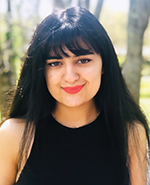 When Hollins announced classes would be online for the rest of the semester, all the international students were still on campus in their dorms. Soon after, Hollins made arrangements for most of the international students to go home and even paid for their tickets. The university arranged transportation to take the international students to Washington, D.C., for their flight. Unfortunately, all of these students came back because they couldn’t go home, because the flights were canceled and the borders of their countries were closed because of the virus. The students were quarantined at the old apartments across the street from the campus.
When Hollins announced classes would be online for the rest of the semester, all the international students were still on campus in their dorms. Soon after, Hollins made arrangements for most of the international students to go home and even paid for their tickets. The university arranged transportation to take the international students to Washington, D.C., for their flight. Unfortunately, all of these students came back because they couldn’t go home, because the flights were canceled and the borders of their countries were closed because of the virus. The students were quarantined at the old apartments across the street from the campus.
Since I had decided not to go home, I had stayed on campus, living in my dorm room in Tinker. After our friends came out of quarantine, all of the international students moved to the apartments. I’m very grateful to Hollins, the way they have responded to this pandemic; the way they treat the international students to make them feel safe. They’re providing us food. They have provided free housing. Our professors and the staff members are checking on us.
My spring semester was going to be my best semester because all the classes I took in the spring were amazing. I was taking a refugee resettlement class, a world religion and politics class, intro to international relations, and cultural geography. I’m a person who understands more when I am with people. When Hollins switched to online classes, I was just devastated. I was like, “This is not for me.” It was difficult for me to keep up, so I had been in contact with my professors. I’m like “I can’t do it. Help me.” I’m so happy that my professors helped me a lot in this and getting me back to the level that I’d been at before.
All the time, I am sad that I cannot see my friends. I cannot see my professors. I cannot go out. I cannot see my parents, and I cannot go back to Pakistan. That made me so depressed, because I thought, “At this point, people should be with their family.” I was really worried about my family back home and they were so worried about me. Since the number of coronavirus cases was so much higher in the United States, my mom would call me twice a day, asking, “How are you doing?”
I had a lot of plans for my spring semester and my summer in the United States, but everything was shot with this one virus hitting the world.
— As told to Beth JoJack ’98
![]()
When Americans first began staying at home as much as possible to slow the spread of COVID-19, Darla Schumm, the John P. Wheeler Professor of Religion and chair of the faculty at Hollins, noticed her friends and family bemoaning the loss of “normal life.”
In these coronavirus dazed days, I keep noticing people yearning for a return to “normal.” Social media accounts are flooded with memories of normal activities from past times. Political pundits prognosticate about when the economy will return to normal. As disability studies scholar Lennard Davis observes, we live in a culture propelled by the “hegemony of normalcy.”
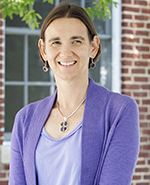 As I faithfully practice social distancing while working from the couch, interacting only with two humans (my husband and son), one dog and one parakeet, several questions float to the surface of my mind. What was this “normal” to which we so desperately long to return? For whom was the “normal” of even just a month ago so wonderful? Do we really want to go back to “normal?”
As I faithfully practice social distancing while working from the couch, interacting only with two humans (my husband and son), one dog and one parakeet, several questions float to the surface of my mind. What was this “normal” to which we so desperately long to return? For whom was the “normal” of even just a month ago so wonderful? Do we really want to go back to “normal?”
Questioning a glorified notion of normal is not new for many of us who live with disabilities. The disruptions, chaos, stresses, fears, anxieties, and uncertainties unleashed by the onset of COVID-19 are all too familiar to people with disabilities. The “new normal,” so unsettling and shocking for the majority of Americans, is, for people with disabilities, simply the old normal. We understand the stress and fear accompanying life in a body that surprises you with its inability (sudden or expected) to perform typical functions. Many of us recognize feelings of loneliness and isolation resulting from social distancing, whether it is externally imposed because of a global pandemic, or because exposure to large groups of people is potentially dangerous to our health even without a pandemic. Still more of us know all too well that the intersections of race, class, gender, and disability exacerbate the precarious nature of our economic stability. In other words, the “new normal” is not new at all; rather it is an old reality avoided, ignored, dismissed, and denied by systems and structures of power and privilege that fuel extreme poverty, inequity, and injustice.
Even as I am acutely aware of the tragic wreckage wreaked by COVID-19, I stubbornly refuse to let the end of this story be one of complete despair. How can we map the terrain of a new normal rooted in principles of justice and equity? What are some religious teachings that can inform our creative imagining and mapping of this future new normal?
The wells of religious teachings for re-molding the contours of the hegemony of normalcy run deep. I offer some entry points into this creative imagining by drawing from the well of Buddhist teachings and from my embodied experience as a person with a disability.
Buddhism teaches that impermanence is the true nature of reality. The only constant in life is that life is constantly changing. Suffering results from our inability to grasp the true nature of an impermanent reality, or conversely, from our clinging to a desire that things remain the same. According to this worldview, it is not change that causes suffering, but our inability to accept the inevitability of change.
Buddhism further emphasizes the interdependence of all sentient beings. We dwell in an interconnected web of existence where my suffering and your suffering, or your joys and my joys, are inextricably linked. Suffering or joy do not belong to any one individual, they belong to the collective community. The medieval Indian monk Shantideva describes it this way: “I should eliminate the suffering of others because it is suffering, just like my own suffering. I should take care of others because they are sentient beings, just as I am a sentient being. When happiness is equally dear to others and me, then what is so special about me that I strive after happiness for myself alone?”
As a blind person, I am intimately acquainted with the Buddhist conceptions of impermanence and interdependence. Inhabiting a non-normative body means that in some circumstances I can count on my embodied knowledge, but in other situations I cannot. Contrary to what most able-bodied folks think, this is neither tragic nor scary; rather it is my normal. In fact, it affords me frequent and welcome opportunities to discover surprising and delightful ways of being in the world. I rarely expect constancy or stability because I understand at a cellular level that life is unpredictable and ever-changing. Likewise, blindness reminds me daily of my interconnectedness with others. There are basic life tasks I simply cannot complete without assistance. As a fiercely self-possessed woman, I have learned to graciously and humbly ask for help, and I in turn strive to return those kindnesses whenever possible.
The novel coronavirus has revealed much about the hegemony of normalcy in American culture and society. It has demonstrated the fragility of some of our most dearly held institutions. It has illuminated with new and disturbing clarity the overwhelming gaps between the haves and have-nots. It has shifted the very foundation of almost everything we thought we knew about the world. Yet, these seismic shifts have also cracked open possibilities for imagining and creating a new normal—a normal grounded in the beauty of impermanence and the gift of interconnectedness.
—A longer version of Darla Schumm’s essay was posted on the Berkley Center for Religion, Peace, and World Affairs at Georgetown University website on April 17. Reprinted with permission.
![]()
Tori Carter ’21, a creative writing major from Halifax County, faced the coronavirus in Japan during her study abroad semester.
My dad was the last family member I saw face-to-face before entering security at the Raleigh-Durham International Airport. After landing at the Kansai International Airport, I used all the Japanese I knew talking to the customs agents. When I bought dinner, I struggled to read the kanji for the different foods. I was surprised to find only one hotel had a vacancy — and it was located 30 minutes away. I wasn’t comfortable with that, so I decided to stay overnight in the airport.
I’d studied Japanese for three years, and I’d eagerly awaited my trip to Japan. It wasn’t the first time I had been abroad; I went on the Jamaica Cultural Immersion Trip during Spring Break. But this was the first time I had ever traveled alone, and I was a little scared.
That night, I kept occupied reading some of the English-language tourist magazines about things to do in Hirakata, where Kansai Gaidai University is based. At some point, as I sat in a near empty airport, it hit me: I was completely alone.
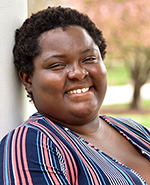 This feeling did not leave me for three weeks. Anxiety, sensory overload, wandering thoughts, and deep episodes of melancholy and depression were everyday issues. It eased a bit as I started classes and focused on my studies. Still, it stayed at the back of my mind.
This feeling did not leave me for three weeks. Anxiety, sensory overload, wandering thoughts, and deep episodes of melancholy and depression were everyday issues. It eased a bit as I started classes and focused on my studies. Still, it stayed at the back of my mind.
It was not long, luckily, until I made some friends. We went together on train rides, day trips on the weekends to Dōtonbori and Kyoto temples, and shared late-night drinks. My unit mates and I had parties where we would make takoyaki (octopus balls), okonomiyaki (a savory Japanese pancake), and celebrate Japanese holidays. I could even walk at 2 a.m. to the nearest convenience store to grab a late snack with my friends. I was on top of the world.
The coronavirus had just started to dominate the news cycle in the United States, but in Japan, it hadn’t yet gotten much airtime. It wasn’t until the end of February, when the first cases in Tokyo started and the virus spread rapidly, that my friends and I started to wonder what would happen with our program. My parents were more worried about me being exposed as I traveled back to the United States than about me staying put.
On my 21st birthday, March 10, administrators announced my program would become fully online from that point forward. They suggested we return home. I was upset to hear my friends planned to leave. The COVID-19 pandemic had not been fully felt in Japan just yet, so it hurt to lose out on an experience I had spent my whole life working toward. It was still safe to travel throughout the prefectures and go out to eat, so I celebrated with one last sushi dinner with my friends.
Before, I had everything planned to leave Japan on May 31. After talking with my parents, we made a plan: I could stay a bit longer as long as I set up a backup plan to return home when it got to be too much. Over another two months in Japan, I took many more day trips to see the sakura trees bloom, went out to nightclubs, and studied at beautiful temples. Finally, I decided it was time. I had experienced all I could, and I missed being in the same time zone as my friends back home. I began my trip back to the United States on May 1.
Because the Kansai International Airport had canceled all flights leaving Japan through May 30, I had to go to Narita Airport in Tokyo to fly out. The six-hour journey to Tokyo was quiet and lonely. On the Shinkansen (bullet train), there was almost no one close to me. Everyone wore their masks, washed their hands regularly, and avoided touching others. The plane rides were just as quiet. I took three connection flights: Tokyo to Seoul, Seoul to Atlanta, and Atlanta to Raleigh. Each flight was near empty, with almost everyone having a row of seats to themselves. Through the whole journey, I wasn’t afraid that I would catch the virus. I had grown accustomed to Japan’s normalized use of masks even before the pandemic, so I trusted others to be safe and wear their masks like me.
When I got to Raleigh, my brother drove me back to Virginia. I would isolate at my mother’s apartment for two weeks before I could even hug my mother or talk to her face-to-face. It was a struggle adjusting back to life stateside, especially in a pandemic. Memories from my time abroad got me through it.
— Written by Tori Carter ’21
![]()
Bri Seoane ’01 took her kids out of school on March 5, a week before the official order came down for California schools to close.
I work very closely with the children’s hospitals in the Bay Area; that’s part of my job at Ronald McDonald House Charities. We provide programming inside the hospitals, so infection control is something we’re really concerned about, because our mission is to offer safe housing and community support and access to health care for the sickest of the sick children, and most of them are immunosuppressed. Because of that, I probably have a little more access to information and understanding about epidemiology, and I could see the writing on the wall.
At that point, our organization had already made the decision to have all nonessential employees work from home. We wanted to get as few people on-site having contact with immunosuppressed kids as possible. But, that weekend, mandatory precautions were issued for hospitals to close down anything considered nonclinical, and that included our Ronald McDonald House and the programs that we were providing. They also would no longer let more than one caregiver into the hospital at a time, so there were all kinds of family members who needed to get home. It was sweeping and it was immediate. I got a phone call Sunday afternoon and it was like: It’s go time, we have to have all of this done by Monday at noon.
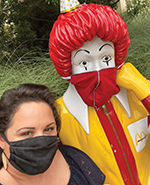 I went into work. My younger daughter was with her dad—we’re separated, and it was his visitation day—so I called my mom to take care of her from that night onward. The next few days, I worked 12 to 14 hour days inside the hospital trying to redirect donations, getting families what they needed before we had to stop our meal program, and dealing with a lot of really emotional parents who were super terrified and not able to be at their child’s bedside anymore. It was incredibly soul-crushing, emotional work.
I went into work. My younger daughter was with her dad—we’re separated, and it was his visitation day—so I called my mom to take care of her from that night onward. The next few days, I worked 12 to 14 hour days inside the hospital trying to redirect donations, getting families what they needed before we had to stop our meal program, and dealing with a lot of really emotional parents who were super terrified and not able to be at their child’s bedside anymore. It was incredibly soul-crushing, emotional work.
When I got home late Tuesday night, it sort of hit me that, although there hadn’t been any positive tests yet, it was very likely there were carriers in the hospitals that just hadn’t been detected. I told my 19-year-old step-daughter—who I have raised since she was seven—that she needed to go to her biological mom’s house for two weeks, because I was concerned that I had been exposed. Same with the little one, I just left her with my mom, packed up a bunch of her stuff, and left it outside my mom’s house. It was totally heartbreaking.
Lo and behold, 10 days later, I got a fever and a headache. I was very flushed. I was wandering around the house in a tank top and underwear. I took a cold shower. I took Tylenol and went to bed. I felt exhausted and drained. I slept for 18 hours a day for four days straight. I had to set alarms so I would get up, hydrate, take Tylenol. I didn’t get the coughing, but I definitely felt pressure in my chest. I also lost my sense of taste, which was really bizarre.
It was a pretty mild or moderate case. I was sick for six days alone at home. I didn’t feel scared. I felt like I had done everything I needed to protect the people I love. If I could think of one word that has described this moment in time for me as a mom, it’s been about protection. It’s about protecting them from a virus when I knew I was exposed to and making that difficult decision.
It’s also about protecting them even now that the courts are closed. My husband and I are separated. We’re not officially divorced yet, because all the courts are closed right now. The reason we split was because of a domestic violence issue, and I had to get a restraining order. Although that is in place, a lot of the details haven’t been fully ironed out. I’ve lost access to all the instruments of the law that I had been relying on to keep us safe and protected all along. We’re in limbo about really important things like visitation and custody and support orders.
Last week, once I was fever-free for 48 hours, I checked with my doctor, and I was able to see my kids again. I spent a couple days disinfecting the entire house and then I went to pick up the little one at my mom’s house. When I picked her up, she was so excited to see me. I burst into tears, because it had been 17 days. I’ve never been apart from her that long.
My oldest came home, but just recently she left, because her mom has needed her to provide care for her younger brother. I’m still calling her, like, “I saw you got a new AP Econ assignment, have you done the readings?” I’m still parenting from afar.
Now, I’m not able to start my workday and focus until after 11 a.m. because my youngest has a morning Zoom class with her teacher and I have to sit next to her for most of her work. I save the things she can do independently for the afternoon, which is when I play defense, trying to keep her occupied while I do my Zoom meetings. I am 100 percent okay with the reckless use of screen-time. Last night I was working after her bedtime, from 8:30 p.m. to midnight, just to catch up.
But now we’re having meals together, which we never did before, because I would get home so late, so she would eat with the sitter or her sister. We’re eating together, she’s helping me cook, those moments are such the silver-lining to all of this. I think I will look back at this as such a gift of time.
—A longer version of this essay, edited by Tracy Clark-Flory, was published on the website Jezebel on April 8. Reprinted with permission.
![]()
The 1918 Spanish Flu
by Peter Coogan, associate professor of history
The disease struck suddenly. People with no symptoms one day became desperately ill within 24 hours and often died within a matter of days. Hospitals were overwhelmed as wards filled with those fighting to live and nurses and doctors joined the sick and dying. Critical supplies disappeared as workers fell ill, production declined, and the transportation network broke down. Unscrupulous vendors took advantage of desperate victims with snake oil remedies and inadequate protections. Scientists and physicians scrambled to find vaccines and treatments, often without adequate financial support or critical cooperation for systematic research. Schools closed, businesses failed, and government operations nearly shut down. Military bases and ships were hit especially hard, but government censorship vainly attempted to keep that information from the public. The president, focused on foreign policy crises, abdicated leadership responsibilities and never expressed sympathy for the thousands of families who suffered losses. Instead, political leaders at all levels of government appeared powerless to do anything but try to rename the disease to focus blame overseas.
At the same time, the country exploded in racial violence. Cities burned as African Americans demanded, and were repeatedly denied, the most fundamental of civil rights. White supremacists struck back with lynching and the destruction of thriving minority economic centers. To many, the country seemed on the verge of disintegration, with the privileged fighting to maintain their prerogatives and the disadvantaged struggling to survive.
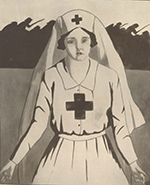
Image from the 1918 Spinster
No, that is not a summary of this week’s CNN, The New York Times, or even the Huffington Post. The events described above all happened in America during 10 months in 1918. Over the next two years, an outbreak of a previously unknown strain of H1N1 influenza killed over 600,000 in the United States and over 50 million, and possibly as many as 100 million, worldwide. Despite frequent governmental references to the “Spanish influenza,” researchers today generally agree that the virus mutated somewhere in Kansas and spread primarily though military training bases for the American Expeditionary Force, which after the country’s declaration of war against Germany in April 1917 was preparing for deployment to the Western Front in the First World War. The disease quickly wiped out whole bases and spread to surrounding communities, as medical professionals seemed helpless to treat it or prevent its spread. President Woodrow Wilson, consumed with winning the war and subsequently dictating the peace, provided neither financial support to the devastated American economy nor moral support to traumatized American communities.
In July 1919, the city of Chicago exploded in racial violence as African Americans sought to swim at the city’s segregated public beaches. Much of the South Side went up in flames and between 38 and 60 residents were murdered. Two years later, the Black district of Tulsa, Oklahoma, known as the Black Wall Street, was burned to the ground by an armed white mob, with the result that the city’s Black residents were either killed and buried in mass graves or forced to leave town with nowhere to go. The violence affected cities across America from 1918 to 1921, with the added targets often including leftist labor unions, Jewish communities, and civic improvement groups not controlled by conservative white citizens. In Indiana, the Ku Klux Klan became one of the most powerful political forces in the state, touting “100% Americanism.”
Today, as in 1918, the nation was blindsided and crippled by a public health crisis. Those tensions exposed visceral cleavages within American society that quickly erupted in violence, demands for fundamental social change, and accusations of “un-American” behavior. When Americans looked to their leaders for help, they found nothing. As John Barry, the author of the bestselling The Great Influenza, wrote in 2004, “Those in authority must retain the public’s trust. The way to do that is to distort nothing, to put the best face on nothing, to try to manipulate no one.” We could have learned much from 1918. We chose not to, at a terrible, terrible price. In the words of Sir Winston Churchill, “In history lies all the secrets of statecraft.”
